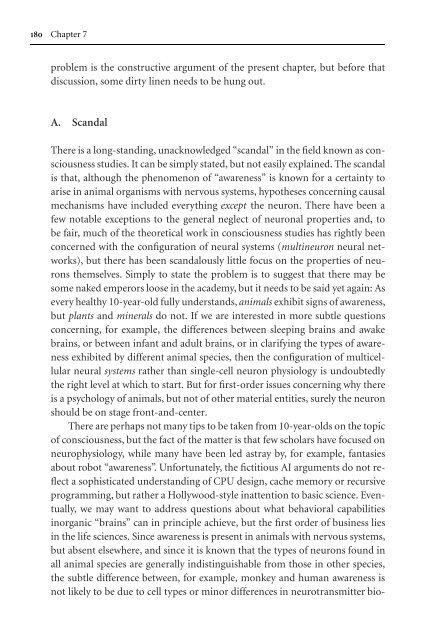Tone of Voice and Mind : The Connections between Intonation ...
Tone of Voice and Mind : The Connections between Intonation ...
Tone of Voice and Mind : The Connections between Intonation ...
Create successful ePaper yourself
Turn your PDF publications into a flip-book with our unique Google optimized e-Paper software.
180 Chapter 7<br />
problem is the constructive argument <strong>of</strong> the present chapter, but before that<br />
discussion, some dirty linen needs to be hung out.<br />
A. Sc<strong>and</strong>al<br />
<strong>The</strong>re is a long-st<strong>and</strong>ing, unacknowledged “sc<strong>and</strong>al” in the field known as consciousness<br />
studies. It can be simply stated, but not easily explained. <strong>The</strong> sc<strong>and</strong>al<br />
is that, although the phenomenon <strong>of</strong> “awareness” is known for a certainty to<br />
arise in animal organisms with nervous systems, hypotheses concerning causal<br />
mechanisms have included everything except the neuron. <strong>The</strong>re have been a<br />
few notable exceptions to the general neglect <strong>of</strong> neuronal properties <strong>and</strong>, to<br />
be fair, much <strong>of</strong> the theoretical work in consciousness studies has rightly been<br />
concerned with the configuration <strong>of</strong> neural systems (multineuron neural networks),<br />
but there has been sc<strong>and</strong>alously little focus on the properties <strong>of</strong> neurons<br />
themselves. Simply to state the problem is to suggest that there may be<br />
some naked emperors loose in the academy, but it needs to be said yet again: As<br />
every healthy 10-year-old fully underst<strong>and</strong>s, animals exhibit signs <strong>of</strong> awareness,<br />
but plants <strong>and</strong> minerals donot.Ifweareinterestedinmoresubtlequestions<br />
concerning, for example, the differences <strong>between</strong> sleeping brains <strong>and</strong> awake<br />
brains, or <strong>between</strong> infant <strong>and</strong> adult brains, or in clarifying the types <strong>of</strong> awareness<br />
exhibited by different animal species, then the configuration <strong>of</strong> multicellular<br />
neural systems rather than single-cell neuron physiology is undoubtedly<br />
the right level at which to start. But for first-order issues concerning why there<br />
is a psychology <strong>of</strong> animals, but not <strong>of</strong> other material entities, surely the neuron<br />
should be on stage front-<strong>and</strong>-center.<br />
<strong>The</strong>re are perhaps not many tips to be taken from 10-year-olds on the topic<br />
<strong>of</strong> consciousness, but the fact <strong>of</strong> the matter is that few scholars have focused on<br />
neurophysiology, while many have been led astray by, for example, fantasies<br />
about robot “awareness”. Unfortunately, the fictitious AI arguments do not reflect<br />
a sophisticated underst<strong>and</strong>ing <strong>of</strong> CPU design, cache memory or recursive<br />
programming, but rather a Hollywood-style inattention to basic science. Eventually,<br />
we may want to address questions about what behavioral capabilities<br />
inorganic “brains” caninprincipleachieve,butthefirst order <strong>of</strong> business lies<br />
in the life sciences. Since awareness is present in animals with nervous systems,<br />
but absent elsewhere, <strong>and</strong> since it is known that the types <strong>of</strong> neurons found in<br />
all animal species are generally indistinguishable from those in other species,<br />
the subtle difference <strong>between</strong>, for example, monkey <strong>and</strong> human awareness is<br />
not likely to be due to cell types or minor differences in neurotransmitter bio-


